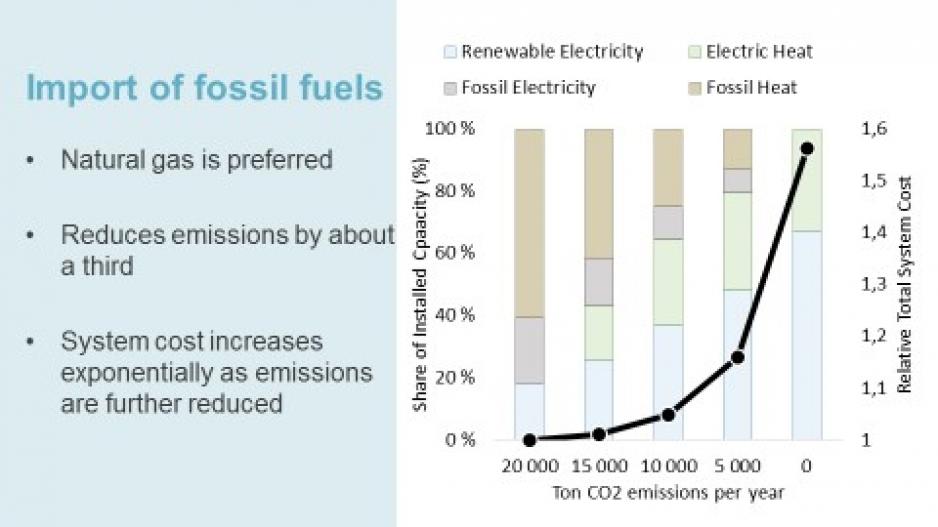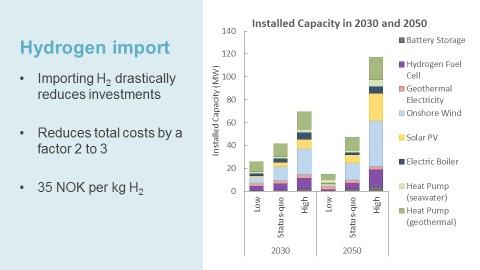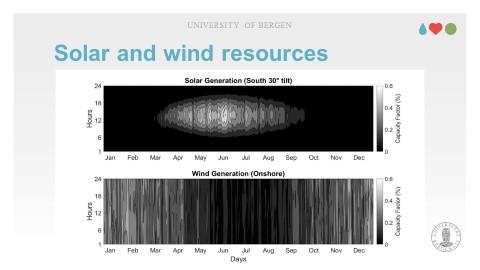
Sustainable Energy System in Longyearbyen Absolutely Possible: - Solar Energy in the Arctic is Underestimated

– En kombinasjon av sol og vindkraft, supplert med noe geotermisk energi og bruk av hydrogen kan gi Longyearbyen et bærekraftig energisystem, mener doktorgradstudent Hans-Kristian Ringkjøb. (Foto: Arne F. Finne).
- Solar Energy in the Arctic is underestimated and renewable energy production in the Arctic is viable now – even in Svalbard.
PhD Candidate Hans-Kristian Ringkjøb at the University of Bergen is convinced.
- Longyearbyen can be supplied with renewable energy to electricity and heating based on currently available technology and within a completely acceptable financial frame.
Ringkjøb, who has about a year left of his PhD, had the opportunity to present preliminary results from his studies at the Arctic Circle event in Reykjavik last weekend.
Given that Mine 7 has coal reserves enough for the Longyearbyen coalmining power plant to last barely 10 years, and given that in some communities in Alaska, one kWh costs more than one dollar, there are many who eagerly await sustainable energy solutions for Arctic regions.
Hans-Kristian Ringkjøb argues that he has parts of the solution, in particular because his model aims to find the best combination of various technical solutions. He also argues that small to moderate emissions should be allowed, amongst others to secure the necessary backup solutions.
- What I have found, is that an energy system in Longyearbyen should be based on a combination of solar and wind power, use of imported hydrogen (from Norway) and also use of geothermic energy, Ringkjøb says to High North News.
He concedes that this will require rather significant investments in infrastructure, however, any new and sustainable energy system in Longyearbyen will do just that.
- Besides, Ringkjøb says, - using hydrogen as energy carrier will reduce investments considerably when compared to a system only supplied by local renewable energy resources (see figure below).

– Bruk av hydrogen som energibærer vil redusere investeringskostnadene betraktelig, påpeker Hans-Kristian Ringkjøb.
The perhaps most important find in Hans-Kristian Ringkjøb’s study is that solar power and wind power complete each other in a place like Svalbard far better than many would have thought.
- While solar energy (pretty obviously) is weak or non-existant in the winter season, it is all the stronger during the summer season.
As for wind power, the situation is opposite, so that these two energy sources complete each other in a good way.
And, he adds: - Both solar cells and wind turbins are more or less off-the-rack items. We do not need to reinvent or re-develop them in any way.
What we have investigated specifically is a combination of solar and wind power and hydrogen, and we have also seen that geothermic energy may provide a good solution for Svalbard.

Sol- og vindenergi på Svalbard utfyller hverandre.
- Hydrogen is not necessarily renewable?
- That depends on how the hydrogen is produced. If it has been produced through electrolysis, which goes through electricity based on renewable energy, hydrogen will also be renewable. Hydrogen is not an energy source in and of itself; it is rather an energy carrier.
- If we assumed that Mine 7 has enough coal for 10 years maximum, then establishing alternatives is a rather urgent matter. Can the solutions that you indicate in your doctoral work come into place in such a limited period of time?
- Like I said, solar cell panels and wind turbines are well-established and existing commodities that can be ordered any time. There is also the opportunity to gradually install modules; one does not need to build a massive power plant right away, but can install and start using it bit by bit.
As these modules are gradually built up, they are phased into the system at the same time as coal-based power is phased out and thus energy becomes more sustainable.
- Costs will matter. What do your calculations indicate?
- Costs drive the entire model that I describe. What is clear, is that the costs of solar and wind power are decreasing rather substantially, in particular for solar energy.
The costs of accumulating or storing energy constitute a major portion, but as I demonstrate in my calculation models, importing hydrogen will dramatically reduce the overall costs – up to 2-3 times when compared to producing and storing hydrogen locally in Longyearbyen. In addition, reserve power based on fossil fuels can further reduce costs, depending on how large emissions are permitted.
- And we are talking about energy for electric power and heat to the households in Longyearbyen, as well as for larger power consumers such as UNIS, the coalmining company, LNS and others?
- We have included everything in the model, save for the transport sector, which may become relevant at a later stage. Should the tourist industry continue expanding, providing land-based power for cruise ships may be relevant, or smaller tourist vessels that can run on hydrogen or electricity, or even snowmobiles on hydrogen.
However, that is something that has to be looked into at a later stage, Hans-Kristian Ringkjøb says.
He argues that the option of providing a power cable from mainland Norway to Svalbard is neither realistic nor viable.
- First of all, investment costs would be very high. In addition, there would have to be a form of backup solution for this ocean bed cable. Even though it is not very likely, a breach on such a cable may take place – and it can take a very long time to repair that. Then one needs to have a backup solution.
If we, as presented here, create a local energy supply based on several sources and significant storage capacity, there will not be any need for a mainland cable in addition.
- How do you concretely envision this? Will there be several small wind power plants, combined with solar power panels on all rooftops, or how will the physical solution be?
- What I have looked at is centralized solar power plants with large solar cell parks, in addition to solar cell panels on rooftops, while also having a wind power plant on Platåfjellet mountain.
Hans-Kristian Ringkjøb argues that the current building mass on Svalbard is rather energy inefficient.
- A lot can be saved through building energy efficiently in Svalbard. And if we manage to reduce consumption of electricity and heat, this will also contribute to descaling the need for installing solar cell panels, wind turbines and other infrastructure in a new energy system.
It is hardly possible to estimate exactly how much it will cost to establish a new energy system for Longyearbyen. That depends, of course, of how the future energy consumption turns out, how business development goes, how much one can improve energy efficiency et cetera.
- It also depends on what will be the preferred solution. However, it is nevertheless clear that if a minimum of burning fossil fuels is permitted as backup solution, investment costs can be significantly reduced.
That will allow increasing security of supply in the system without being dependent on many and sizeable renewable installations. Such backup solutions can e.g. be gas turbines or similar.
- I did of course note, with some joy, that Statkraft Director Christian Rynning-Tønnesen said the other day that Svalbard’s energy supply must be renwable and built on sun, wind and hydrogen, Hans-Kristian Ringkjøb says to High North News.
This article originally appeared in Norwegian and has been translated by HNN's Elisabeth Bergquist.

